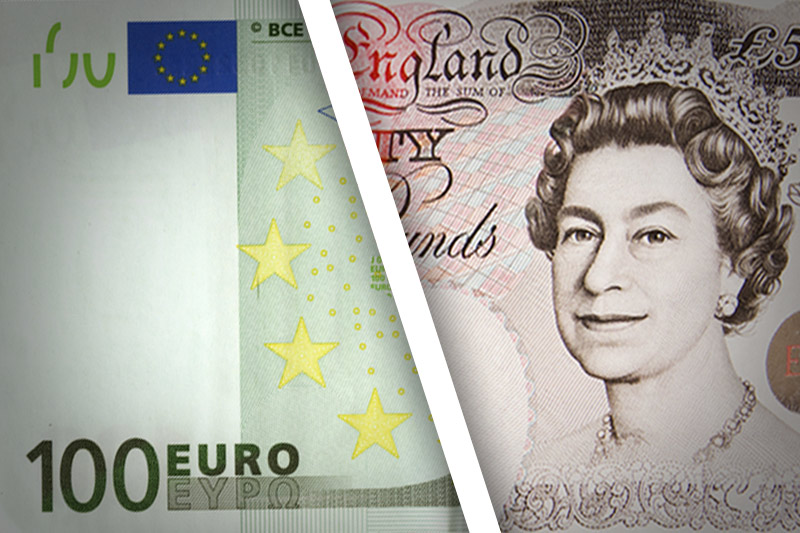Investing.com - The euro fell to a more than one-week low against the pound on Wednesday, after weak euro zone manufacturing data and worsening German business sentiment added to concerns over the economic impact of the region’s debt crisis.
EUR/GBP hit 0.8086 during European morning trade, the pair’s lowest since October 16; the pair subsequently consolidated at 0.8089, shedding 0.63%.
The pair was likely to find support at 0.8053, the low of October 16 and resistance at 0.8147, the session high.
The euro’s losses came after data showed that the flash euro zone manufacturing purchasing managers’ index fell to 45.3 in October from a final reading of 46.1 in September. Analysts had expected the index to ease up to 46.6 in October.
A separate report showed that the euro zone’s service’s PMI inched up to 46.2 in October from 46.1 last month.
Germany’s flash manufacturing PMI fell to 45.7 in October, from a final reading of 47.4 in September, adding to concerns over the euro zone’s largest economy.
Elsewhere, a report by German research institute Ifo showed that its business climate index fell to100.0 in October, the lowest level since March 2010, from a reading of 101.4 in September.
The weak euro zone data offset a report earlier showed that China's HSBC manufacturing PMI improved to 49.1 in October, compared with a final reading of 47.9 in September.
Sentiment on sterling remained underpinned after comments by Bank of England Governor Mervyn King dampened expectations for more easing by the central bank.
In a speech late Tuesday, Governor King said policymakers would have to think "long and hard" before implementing further quantitative easing measures.
Investors were anticipating preliminary data on U.K. economic growth on Thursday, amid expectations that the report will show that the economy expanded in the third quarter, following three successive quarters of contraction.
The pound was higher against the euro, with GBP/USD up 0.31% to 1.6001.
Later Wednesday, the Federal Reserve was to announce its benchmark interest rate and release its first monetary policy statement since the central bank announced a third round of quantitative easing in September. The U.S. was to release official data on new home sales.
Meanwhile, European Central Bank President Mario Draghi was to attend a meeting in Germany’s central bank, which was to be followed by a press conference.
EUR/GBP hit 0.8086 during European morning trade, the pair’s lowest since October 16; the pair subsequently consolidated at 0.8089, shedding 0.63%.
The pair was likely to find support at 0.8053, the low of October 16 and resistance at 0.8147, the session high.
The euro’s losses came after data showed that the flash euro zone manufacturing purchasing managers’ index fell to 45.3 in October from a final reading of 46.1 in September. Analysts had expected the index to ease up to 46.6 in October.
A separate report showed that the euro zone’s service’s PMI inched up to 46.2 in October from 46.1 last month.
Germany’s flash manufacturing PMI fell to 45.7 in October, from a final reading of 47.4 in September, adding to concerns over the euro zone’s largest economy.
Elsewhere, a report by German research institute Ifo showed that its business climate index fell to100.0 in October, the lowest level since March 2010, from a reading of 101.4 in September.
The weak euro zone data offset a report earlier showed that China's HSBC manufacturing PMI improved to 49.1 in October, compared with a final reading of 47.9 in September.
Sentiment on sterling remained underpinned after comments by Bank of England Governor Mervyn King dampened expectations for more easing by the central bank.
In a speech late Tuesday, Governor King said policymakers would have to think "long and hard" before implementing further quantitative easing measures.
Investors were anticipating preliminary data on U.K. economic growth on Thursday, amid expectations that the report will show that the economy expanded in the third quarter, following three successive quarters of contraction.
The pound was higher against the euro, with GBP/USD up 0.31% to 1.6001.
Later Wednesday, the Federal Reserve was to announce its benchmark interest rate and release its first monetary policy statement since the central bank announced a third round of quantitative easing in September. The U.S. was to release official data on new home sales.
Meanwhile, European Central Bank President Mario Draghi was to attend a meeting in Germany’s central bank, which was to be followed by a press conference.
